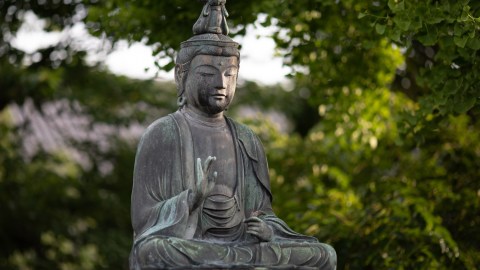Alan Watts and the art of meditation

- Alan Watts cuts to the root of what meditation really is all about.
- Meditative practice has no motive, except to experience the present moment.
- Practice a guided meditation by focusing on the now.
Meditation has left the ashrams and become a fixture in the boardroom and livings rooms everywhere. The corporate analysts and Silicon Valley-types scramble for their next hit of improvement. Spiritual posturing and enlightened one-uppers fill our social feeds and make it seem like meditative bliss is just a hashtag away. Unfortunately as spiritual practices enter into the wide marketplace of ideas, there is a tendency for them to be degraded and repackaged into self-improvement drivel and self-serving nonsense.
It’s best to avoid the commercialization of contemplation if you want an authentic experience of meditation. It’s a really simple thing to do.
The increased cultural awareness of meditation is still cause for joy, but more importantly a cause for education. So let’s clap one hand together and see what the sage Alan Watts has to say on how to meditate.
“Meditation is the discovery that the point of life is always arrived at in the immediate moment. And therefore, if you meditate for an ulterior motive — that is to say, to improve your mind, to improve your character, to be more efficient in life — you’ve got your eye on the future and you are not meditating!”
What is the purpose of meditation?
The goal of meditation is quite simple. To be within the here and now. To divorce yourself from symbolic language, hangups of time and experience the immediacy of the present moment. Meditation practiced for this reason transcends everything else. Once this fundamental point is grasped, you can meditate in anyway you see fit. Twisted criss cross in a yoga pose or sitting on a park bench in a busy city street.
The problem is, this straightforward idea is complicated by our categorical mind that won’t stop chattering. Always in the process of labeling an experience or forcing logic and reason when there is no need for it. It’s almost comical, but a lot of people get stressed by the idea of just sitting still and doing nothing. Emptying the mind becomes another thing to think about. According to Watts:
“The art of meditation is a way of getting into touch with reality. And the reason for it is that most civilized people are out of touch with reality because they confuse the world as it is with the world as they think about it, and talk about it, and describe it. For — on the one hand — there is the real world and — on the other — a whole system of symbols about that world which we have in our minds.”
He understood that being human and being part of a civilization are tied to symbolic thinking and of course this fundamental aspect of humanity — language — which is a useful thing. Yet it does have its disadvantages, chiefly one of those being confusing the symbol for the actual thing. An example of this is when Watts touches how we confuse money for actual wealth.
“Meditation is the way in which we come to feel our basic inseparability from the whole universe, and what that requires is that we shut up. That is to say, that we become interiorally silent and cease from the interminable chatter that goes on inside our skulls. Because you see, most of us think compulsively all the time.”
Tomorrow never comes. This is more than mere metaphysical pronouncement or sophomoric existential wailing. It’s an adage we can take to heart. For the future is and always will be just a concept. Meditation puts us back into our place of the now.
It’s a kind of digging the present, it’s a kind of grooving with the eternal now, and brings us into a state of peace where we can understand that the point of life — the place where it’s at — is simply here and now.
So should you have a reason for meditating? At most, we can say that the purpose for meditating is for a kind of enjoyment and gateway into the present moment.
How to meditate
There is no one way to meditate. There are a countless number of Eastern texts regarding the practice and many different methods and techniques. There are a few central tenants that serve as a foundation for meditation, though. Alan Watts describes the following as:
“You can sit any way you want. You can sit in a chair, or you can sit like I’m sitting — which is the Japanese way of sitting — or you can sit in the lotus posture… the easier you’ll find it to do — or you can just sit cross-legged on a raised cushion above the floor. Now, the point of this is that if you keep your back erect… you are centered and easily balanced, and you have a feeling of being thoroughly rooted to the ground.”
Now there’s not much more to be said, once this is figured out. You can complicate the game a bit and have some more fun with it in an authentic yogic practice. There are all sorts of mantras and breathing techniques you can throw in there as well. But the point still stands, to meditate is to be in the now.
You can practice this now with a guided meditation by Alan Watts (see below).





